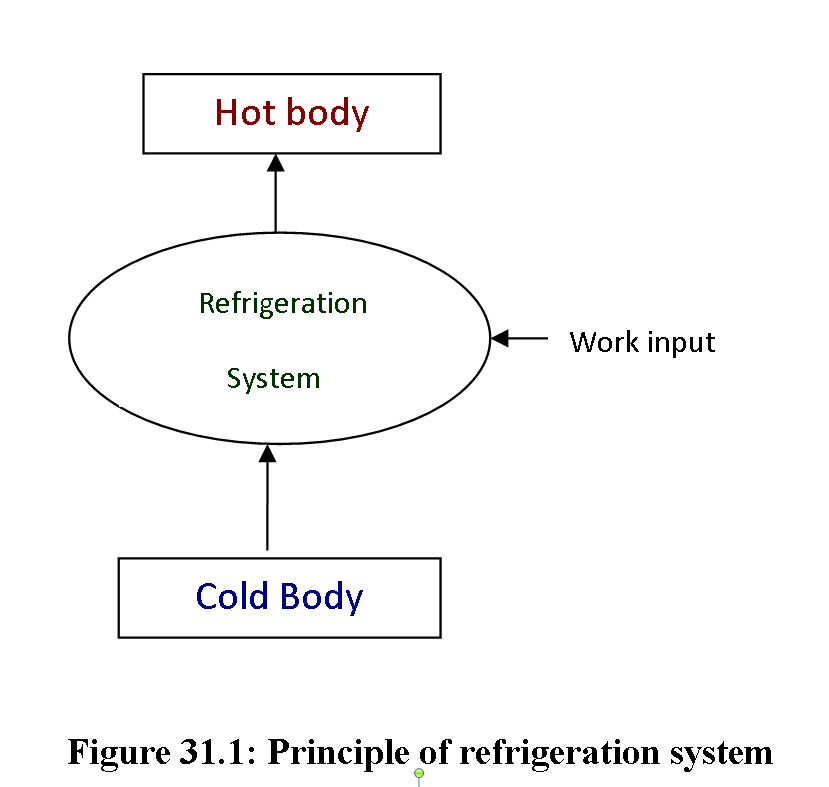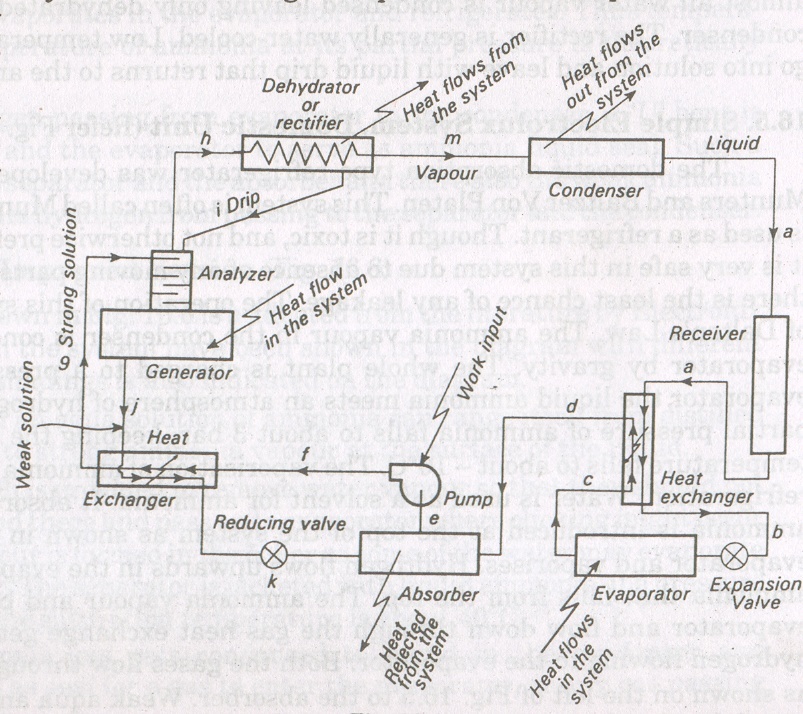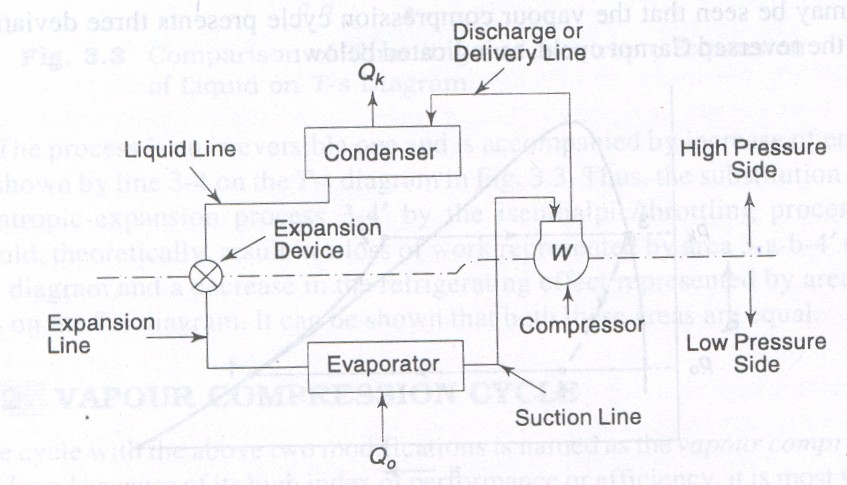Site pages
Current course
Participants
General
Module 1. Dairy Development in India
Module 2. Engineering, thermal and chemical proper...
Module 3. Unit operation of various dairy and food...
Module 4. Working principles of equipment for rece...
Module 5. Dairy plant design and layout, compositi...
Module 6. Deterioration in products and their cont...
Module 7. Physical, chemical and biological method...
Module 8. Changes undergone by the food components...
Module 9. Plant utilities requirement.
References
Lesson 31. Refrigeration Systems
31.1 INTRODUCTION
The American Society of Heating, Air conditioning and Refrigerating Engineers (ASHARE) defines refrigeration as the science of providing and maintaining temperatures below the immediate surrounding temperatures. Thus it is a process of removing heat from a medium. In other words, the term “refrigeration” is used to denote maintenance of a system or body at a temperature lower than that of its surroundings. This enclosed space can be a refrigerator cabin or deep freeze cabin or cold storage, etc. that is being used to store food/ dairy products at low temperature. Refrigeration has very wide applications such as food preservation in domestic as well as in food/dairy industries, ice- manufacturing, ice cream manufacturing, textile industries, etc.
31.2 PRINCIPLE OF REFRIGERATION
The principle of refrigeration is based on second law of thermodynamics. In refrigeration process, since the heat has to be transferred from a low temperature body to a high temperature body some external work has to be done according to the second law of thermodynamics as shown in Fig.31.1. This external work is done by means of compressor.

31.3 Importance of Refrigeration in Dairy Industry:
Refrigeration is a basic requirement for the processing and storage of milk and milk products as majority of dairy products are perishable in nature. The need of refrigeration is indicated below.
Chilling of milk at producers’ level by employing bulk milk coolers and at milk chilling centres is the first requirement in dairy industry. Immediate cooling of milk to about 2-3 ºC is very important to reduce the multiplications of micro-organisms and to get low bacterial count in the milk and milk products.
Processing of milk using either batch pasteurizer or HTST plant requires chilled water or any other cooling medium for cooling of milk.
Manufacture of many products requires refrigeration. e.g. butter, ice-cream etc.
Storage of milk and milk products requires maintaining low temperature in the cold storages depending on the type of product to be stored. e.g. milk is stored at around 3-4 ºC while ice-cream is stored at -30 ºC temperature.
Transportation of many products requires refrigerated vehicles to maintain the quality of products.
Low temperature storage is required at distribution of products as well as at the consumers’ level.
A refrigeration system is an important and integral part of Dairy Industry. There are numerous types of refrigeration systems depending on different size, design, application, capacity of cooling or low temperature to be maintained, etc. But the principle of refrigeration in all these equipment is mostly common and that is ‘vapour compression refrigeration’. The basic major components of refrigeration systems are compressor, condenser, expansion valve and evaporator. Some of the major refrigeration systems used in industry are mentioned as below:
Ice Refrigeration
Evaporative Refrigeration
Refrigeration by Expansion of Air
Refrigeration By throttling of the Gas
Vapour Compression Refrigeration
Vapour Absorption Refrigeration System
Steam- Jet Refrigeration System
Refrigeration by Using Liquid Gasses
Dry ICE Refrigeration
31.4 Unit of Refrigeration:
Capacity of refrigeration system is expressed as ton of refrigeration (TR). A ton of refrigeration is defined as the quantity of heat to be removed in order to form one ton (2000 lbs.) of ice at 0 ºC in 24 hrs, from liquid water at 0 ºC. This is equivalent to 12600 kJ/h or 210 kJ/min or 3.5 kJ/s (3.5 kW).
1 TR = 12600 kJ/h or 210 kJ/min or 3.5 kW
The capacity of refrigeration plant required in any dairy/food plant can be estimated based on the cooling load requirement of the plant.
31.5 Principle of Vapour Compression Refrigeration (VCR) System
Any type of vapour compression refrigeration system has the same principle of working. A fixed quantity of refrigerant, which is any suitable gas, is filled in the closed system of four components, i.e., compressor, condenser, expansion valve and evaporator connected to each other through tubes. When the compressor is run, the refrigerant starts flowing through the system i.e., the system starts it’s working. The compressor continuously sucks low pressure, low temperature refrigerant vapors from the evaporator and pump these to condenser at high pressure and high temperature condition. While flowing through the condenser, the high temperature vapors release their heat to atmosphere and condense to high pressure liquid state. After condenser this high-pressure liquid enters the expansion valve where it is throttled to low pressure. It is so constructed that a control quality of refrigerant flows (due to expansion valve) from one necessary steps to another at definite and predetermined pressure. On throttling the pressure and temperature of refrigerant (like ammonia, R-22 etc.) decreases and when this low pressure, low temperature throttled liquid flows through evaporator, it sucks heat and produce cooling. On absorbing heat in evaporator all the low-pressure liquid evaporates to low-pressure, low-temperature vapors, which are again sucked by compressor. In this way all these processes go on continuously and as long as the compressor runs, the system produces cooling around the evaporator. A block diagram of a vapour compression refrigeration system is shown in Fig. 31.2. . The refrigeration system is an enclosed gas tight system of tubes and equipments as shown below.
1 Evaporation
2 Compression
3 Condensation
4 Pressure reduction or Expansion
31.6 Components of the VCR system
31.6.1 Compressor
It is the main component of a Refrigeration System. It may be of many types but a reciprocating compressor is commonly used for different cooling applications in a dairy industry. In this type when an electric motor rotates the main shaft of compressor, a piston reciprocates i.e. moves up and down in the cylinder of compressor. While moving down, the piston sucks the refrigerant vapours coming from the evaporator through suction valve and while moving upward, it compress (increase the pressure of) these vapours and discharge them to condenser through discharge valve. In this way, the basic working of a reciprocating compressor is exactly same as that of a cycle pump.
The purpose of the compressor is to draw low-pressure refrigerant vapour from the evaporator, and compress it so the vapour can be condensed back into a liquid by cooling with air or water. The compressor is the workhorse of a refrigeration system and usually accounts for between 80% and 100% of the system’s total energy consumption. It is important, therefore, that the system operates under optimum conditions. The amount of energy used by a compressor is affected by the:
Type of compressor
Compressor load
Temperature difference of the system (i.e. the number of degrees by which the system is required to cool).
Fig. 31.2 : Block diagram of vapour compression refrigeration system
31.6.2 Condenser
The role of a condenser is to reject heat of compressed refrigerant to atmosphere by providing large area for heat exchange. It is named as condenser because by rejecting latent heat of refrigerant it condenses the refrigerant i.e. converts it from vapour to liquid state. In a Dairy Industry, either shell and tube type or evaporative type, also called as atmospheric condenser is used. Shell and tube type condenser is most satisfactory condenser in case there is no scarcity of cooling water. But its initial cost is high with separate cooling tower. On the other hand, when there is water shortage and cooling tower is being used, then generally the evaporative condenser is more suitable especially in case of large plants.
31.6.3 Evaporator
It is the most required important part of the refrigeration system. The refrigerant from the expansion valve comes in to the evaporator below the temperature required to be maintained in the evaporator and carries the heat from the evaporator.
The evaporators are mostly divided in to different categories as:
1) Flooded Evaporators
2) Dry-expansion Evaporators
a) Natural Convection Evaporators
b) Forced Convection Evaporators
3) Shell and Tube Evaporator
4) Shell and Coil Evaporator
5) Double Pipe Evaporator
6) Plate Evaporator
7) Baudelot-Cooler
31.6.4 Pressure reduction or Expansion:
Expansion valve is one of the basic components of the refrigeration system. The refrigerant is in liquid stage under high pressure in the receiver and it is ready for reuse in the evaporator where much lower pressure is maintained. Some means of retaining of pressure difference is required. This is done by arranging a throttling device in the line between receiver and evaporator. This throttling maintains a higher pressure on one side and allows a lower pressure condition to exist on the other side when flow of refrigerant occurs.
It reduces the pressure of the refrigerant coming from the condenser and temperature also as per the requirement of the system. It also regulates the flow of the refrigerant as per the load on the evaporator. Refrigerant is a the heat transfer medium in vapour compression refrigeration cycle which absorbs the heat through evaporation at the evaporator and rejects the heat absorbed at evaporator plus the heat of work of compression at the condenser. Different devices which are used to perform above functions, are as under:
Capillary Tube
Pressure Control or Automatic Expansion Valve
Thermostatic Expansion Valve
High-side float Valve
Low-side Float Valve
Solenoid Valve
Regarding expansion valve, thermostatic expansion valve is most commonly used in a mid size refrigeration system. In small unit generally capillary tube is preferred because of its low cost, simple working and no maintenance required, etc.
31.7 Primary refrigerant:
The working fluid of vapour compression refrigeration system is known as primary refrigerant which absorbs the heat through evaporation at the evaporator and again becomes liquid on cooling in the condenser. Primary refrigerants include only those working fluids which pass through the cycle of evaporation, compression, condensation and expansion. These refrigerants have very low boiling point. e.g. boiling point of ammonia is -33.3 º C at atmospheric pressure. There are many refrigerants which as discussed in another lesson.
31.8 Co-efficient of Performance (C.O.P.):
The performance of the refrigeration system is expressed as C.O.P. which is the ratio of refrigerating effect produced to the work of compression. The cooling effect (out put of the system) is produced at the evaporator and the refrigerant is compressed by the compressor using the electrical power (input to the system). The various aspects associated with performance of the system are discussed in some another lesson. Higher C.O.P. is always desirable in order to get more cooling effect with less energy in put
31.9Absorption refrigeration
Absorption chillers allow cooling to be produced from heat sources such as clean fossil fuels, incinerated garbage, bio fuels, low-grade steam, hot water, exhaust gas or even solar energy, usually using a lithium bromide and water refrigerant (Broad Air Conditioning 2004). The COP of absorption refrigeration, however, is relatively low compared with vapour compression refrigeration systems with the best absorption chillers generating just over 1 kW of refrigeration for 1 kW of energy. The higher the temperature of the waste heat, therefore, the more effective the refrigeration will be. The advantages of absorption chillers are that they can utilize a waste heat source with lower greenhouse gas emissions compared to conventional vapour compression refrigeration systems. Figure 31.3 shows engineering features of Vapour absorption refrigeration system.

Figure 31.3_ Block Diagram of Vapour Absorption Ammonia System
31.10 Defrosting
Hot gas from the outlet of the refrigeration compressor can be used to defrost freezers, but the control must be accurate. The defrost water may then be used elsewhere in the plant. Once installed and optimized, a hot gas bypass defrost system can ensure frost-free evaporator operation. Once the evaporator is no longer covered in ice its cooling capacity will be increased.
31.11 Reducing load on refrigeration systems
Up to 10% of the power consumption in refrigeration plants can be from heat ingress through doorways in cool rooms. Many plants rely on good operator practice to keep doors closed, but this is not always effective. Automatically closing doors or an alarm system could be considered; and plastic strip curtains or swinging doors are useful at frequently opened entrances. Lights and fans also add to the heat load.
Sensors and timers can be used to ensure that lights are used only when necessary. Variable speed drives, coupled with a programmable controller, can cycle off fans and refrigerant feed during low load times. Cooling water loops using water at ambient temperature have also been used by some dairy processors to pre-cool high-temperature fluids (around 90°C) before chilling, thereby reducing the load on the refrigeration system.
